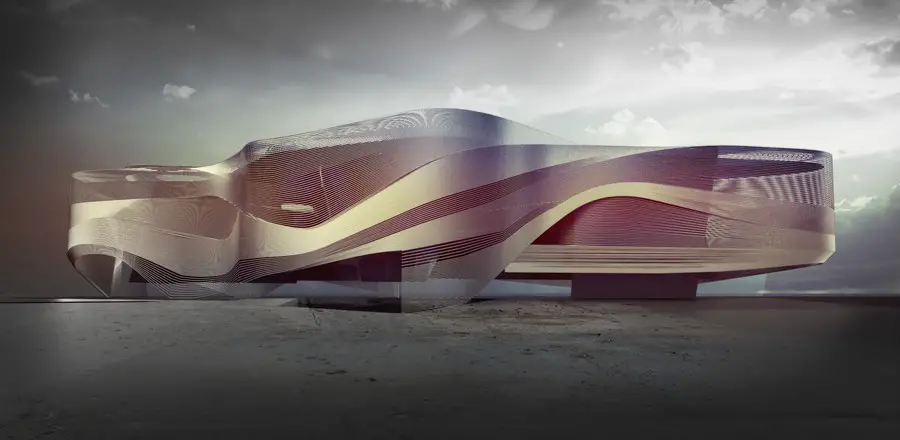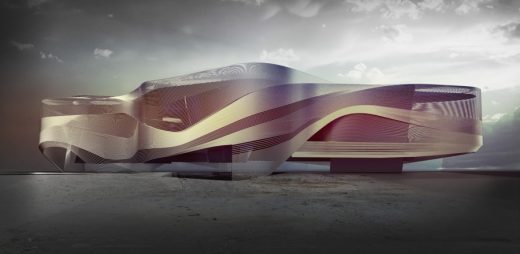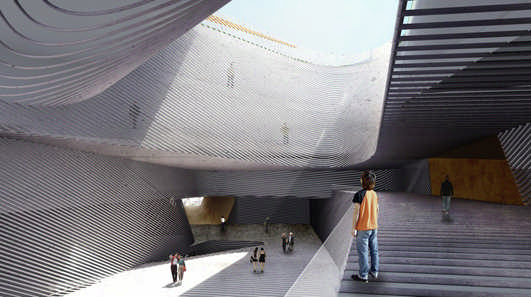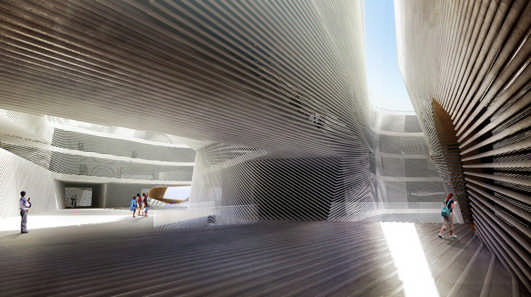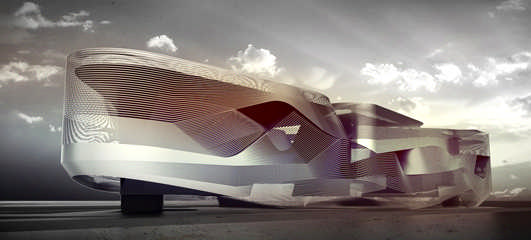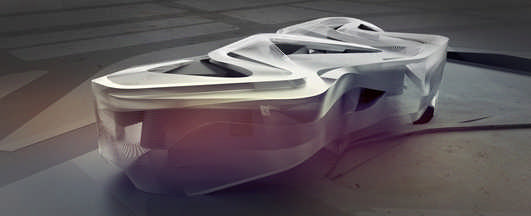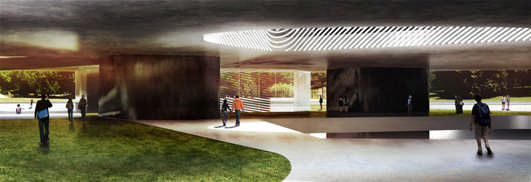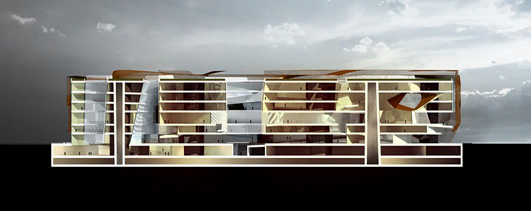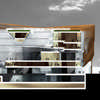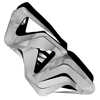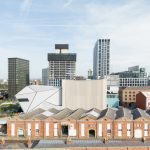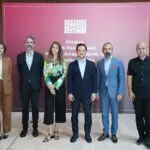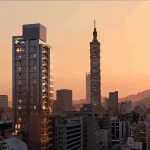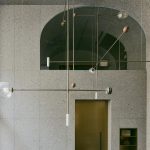Taichung Cultural Center, Taiwan Building Design, Taiwanese Architecture
Taichung City Cultural Center, Taiwan
Taiwanese Building Proposal design by Santiago Parramón, RTA-Office
post updated 30 Mar 2021 ; 21 Jun 2013
Taichung City Cultural Center
Design: Santiago Parramón, RTA-Office
Location: Taiwan
Taichung City Cultural Center
Description:
This proposal is strongly based on the idea of a container — a unique vessel that encompasses a multitude of architectural objects, various spaces, and the relationships between them. Inspiration for the design of this shape was derived from traditional Taiwanese basket weaving.
The final result is a unitary transparent skin that allows stolen glimpses of the complexity that lies inside. Thus this object becomes a contemporary interpretation of an ancient traditional art and culture. Comprised of thin lines of recycled ceramic elements, the skin gently filters the light that reaches the interior and enhances the shapes of the volume. The skin of our design not only serves to enhance the aesthetic value of the building, but it also reduces our impact on the natural environment by taking advantage of passive technologies such as solar shading and natural day lighting.
Our interior intrigues the visitor with interesting juxtapositions and connections through the design of inseparable public spaces and programs. The volume of the building has been cut on the interior by a series of interconnected voids to allow the penetration of natural light and natural ventilation. This design further provides an experience of unexpected relations between the two main programs: the museum and the library.
We reach these voids through a network of public spaces that intertwine the museum and library, penetrating the depth of the building, beginning with the park level and reaching as high as the third floor. This unconventional design leaves us with a large porous object, drawing in visitors from both the park and the main street, and directing them to the third level through an organic gradation between the natural and built landscape where they are left with uncompromised views of the Taichung Gateway.
The intricacies that lie within the woven object are not only a direct reflection of the rich culture of Taiwan, but it is also a parallel to the elaborate nature that is associated with sustainability. Like the woven bamboo, we believe the beauty lies in the convergence of these intricacies, producing a singularity—weaving an interdependent whole.
The Public Library and the Fine Arts Museum spaces are organized around a fluid a public space where all the functions are integrated and connected while maintaining their independence.
The building is organized on two main public floors, the first and the third. The first floor is conceived in continuity with the park, is completely permeable and accessible either from the street side or from the park, without obstructing the visual and physical connection between the two parts.
From the first level an open air ramp brings the visitors to the museum lobby which is located in the first basement, here is the access to the Permanent Exhibition Area.
In the other side of the building a public elevator brings the visitors directly to the Lobby of the library, located on the third level.
There are two open ramps connecting the first with the second floor, where the administration, research and education spaces are organized around a fluid and permeable space. From this space there is another open ramp that takes people to the third level.
In the third level the special collection area of the museum and other exhibition spaces, the lobby and the public services of the library are organized around a vast public space that is open to the street and the park. The fourth, fifth and sixth levels are all dedicated to the Library and are accessible only from the lobby on the third floor.
The Library is conceived as a continuous open space where all the different reading areas and cultural resources can be connected between each other using direct vertical connections (stairs, elevators) or gentle ramps that ease the manipulation of books. These ramps continue all the way to the roof of the building to the open air reading spaces.
The cores of the building have a double role, acting both as structure and as vertical circulation, containing the elevators and fire evacuation stairs.
The building is a large porous object that collects and draws in the visitors coming from the park or the main street; it takes them to the third level where it offers them elevated views of the surroundings and the landscape.
Taichung Cultural Center – Building Information
Project Name: Taichung City Cultural Center
Location: Taichung, Taiwan
Area: Site area: 2.6 hectares
Built-up Area: 62.700 m2
Program: Library, Conference hall, Museum, Archive, Classrooms, Research rooms, Offices, Public services and Parking
Completion Date: 2013 competition entry
Landscape Design: Santiago Parramón, RTA-Office
Interior Design: Santiago Parramón, RTA-Office
Team: Miguel Vilacha, Isabel Granell, Javier Gonzalez, Alex Muntean, Teodor Cozma, Elisa Ascari, FeiFeiZhang, Chunhui Tian, Shoaib Asif, Lindsey J. Hirsch, Simona Assiero Brá.
Environmental and energy consultants: Fabian Lopez, Daniel Calatayud.
Photography: All images courtesy of RTA-Office
Client: Taichung City
Total Construction Budget: 62 million euro
Taichung Cultural Center Building – Further Information
In order to effectively assimilate all sustainabilty criteria, our team performed an analysis of the green labeling certification systems and developed the following categories:
Siting & Biodiversity
With special attention paid to low impact development, we have kept the building compact, have provided no roads for vehicular transportation, located parking underground, and have incorporated vertical façade and roof vegetation wherever possible. Through multi-layer greening techniques, we improve local species richness while providing a diverse landscape that highlights the native flora and fauna of Taiwan.
We further minimize the building footprint by maximizing open space for the preservation and enhancement of the natural landscape. Our desire to have an organic and symbiotic relationship between the natural environment and the built landscape is conveyed through the ground floor of our design, which provides a fluid environmental transition from Taichung Gateway Park to the street without interruption in scenery.
While we provide no roads for vehicular transportation, our design does include an underground parking garage that has made provisions for the parking of alternative fuel or low-emitting vehicles. Further, we have installed storage racks near the entrances of both of our lobbies to promote carbon free transportation.
Water
The intent of water design for the building is to reduce consumption to the point where all water is reused on-site. We plan to achieve this by utilizing water-efficient plumbing fixtures that exceed the efficiency levels currently provided by market regulations. For example, we plan to install: photoelectric or low-flow faucets, pressure regulators, aerators, dual-flush toilets, and waterless urinals.
The core of our water use design focuses on passive green infrastructure strategies throughout the project, such as the green roof. The building’s design also includes a grey water system that harvests all rainwater that falls on-site for irrigation purposes through rainwater catchment pools located on the ground floor of the project site for storage and filtering processing. Further, to meet the needs of the native species throughout the project, we plan to include efficient irrigation strategies, such as drip irrigation.
Additionally, we propose utilizing a mechanical separation system and fecal composting toilets in combination with the previously mentioned grey water recycling system. This closed-loop method of dealing with the site’s waste would allow the building to be considered “off-grid” and would subsequently reduce the load on the surrounding Taichung’s network.
Materials & Resources
Our environmental selectivity minimizes resource consumption while maximizing closed-loop material lifecycles and recycled materials. Our strategy is to reduce material consumption per unit of service, decreasing the environmental impact of the material. We predominantly use rapidly renewable materials when they are natural and recycled materials when they are industrial.
Within the framework of technical and economic feasibility, we use 100% recycled and 100% recyclable materials such as: certified sustainable and recycled wood panelling (CLT wood), steel, and fly-ash concrete (less than 5% of total structural materials) in our structure, and using recycled aggregates from construction for landscape draining purposes and in structural concrete. We additionally incorporate locally sourced materials, and green building material label products for reduced environmental impact whenever possible.
Indoor Environment
Our design process took into careful consideration the entire life cycle of the building, paying particular attention to the uncertainty of the future. Thus, our guiding principle became the concept of adaptive reuse. Throughout the building, we have designed spaces that provide the opportunity for various functionalities. These spaces being allocated for flexible purposes allows the visitor a sense of discovery and a changing interior landscape that encourages visitors to return for a new experience, as well as provides numerous opportunities should the building no longer be used as a library or museum.
Additionally, integral to our design was the provision of a comfortable indoor environment. We accomplished this through several strategies, such as: natural ventilation through patio spaces created by the distance between the external skin and the inner structure, natural ventilation and day lighting through the open-air columns, interior vegetation that removes toxins from the environment, operable windows, and simple sustainable interior furnishings (green building material label products with low to no volatile organic compounds).
Energy & Atmosphere
Achieving Diamond Level EEWH certification, as well as LEED Platinum certification required special attention to the energy and carbon implications of our design. In regards to the interior climate, we have taken into consideration the different demands of comfort for various spaces throughout the building. We have divided the project into distinct zones, limiting the volume and necessity of air conditioning while maximizing passive strategies for ventilation and air renewal.
For example, the design includes several large open-air columns that achieve multifunctional purposes. These columns serve as: courtyards, catalysers of natural ventilation, dissipaters of heat, sources of natural daylight, and opportunities for social exploration. These columns are further lined with vegetation, helping to remove toxins from the indoor air environment and increasing the biodiversity of the building.
The external skin of the structure was designed specifically to regulate the solar radiation and intensity of the building, further reducing the energy demand associated with cooling.
This skin makes use of diffuse radiation, a day lighting technique that optimizes the penetration of sunlight into the building, reducing the need for artificial lighting, and directly creating energy savings for both the electrical and internal load. While the external skin provides a generous amount of solar shading, the occupant’s views of Taichung are not compromised.
We have placed building-integrated thin film solar over the external skin on the roof of the project in order to deliver power to the building’s geothermal heat pump and solar desiccant air-conditioning system.
A solar battery storage system will collect excess thermal power to be used for powering the building at night. In combination with this external skin, triple glazed windows, air-sealing, and extremely efficient insulation, we have designed a high-performance building envelope.
The passive design strategies that we have included for this project are balanced by the use of active systems that maximize renewable sources of energy. Instead of air-conditioning the entire volume, only the zones where visitors are anticipated will be conditioned. To meet the demand that has been reduced by the passive strategies, we include a radiant cooling system and a convective heating system. The heating system is comprised of recycled fly-ash concrete panels that have water ducts with the ability to pass heating or cooling; the radiant cooling system is located in a space of moisture control that avoids the risk of condensation, ensuring the longevity of this technology.
Using occupancy & vacancy sensors for the highly efficient lighting and ventilation installations allows our building to further limit the energy consumption associated with internal occupant comfort. We have included, in the design, a hybrid mechanical ventilation system that prioritizes natural ventilation when possible. The system is designed so that if air exchange levels fall below a specified limit, the mechanical ventilation is automatically activated. This system also makes use of the mechanical ventilation when the outside air conditions are not optimal or beneficial for building inhabitants.
In order to enhance the social aspect of sustainability into our project, we wanted to design a facility that both educated and inspired the building’s visitors. To do this, we have incorporated interactive behaviour-based efficiency measures into the facility. Specifically, we have designed a system located on the ground floor of the building that displays real-time feedback of the building’s performance.
The interactive screens display the current carbon intensity, energy consumption, energy production, and water use load of the building. It is our intention that this experience encourages visitors to think about their own environmental performance beyond the duration of their visit. We are able to utilize this technology through our Intelligent Building System that uses smart metering to monitor, manage, and respond to the slightest variations of building performance, essentially making the building a living building.
Waste
The building is comprised of industrialized solutions that minimize the amount of waste that will be generated on site. Inherent in our design process was the provision of reusing all surplus construction materials and land excavation on-site. We intend to conduct a detailed study and develop a waste management plan for the construction phase of the project, minimizing our carbon impact on the local landscape. Additionally, we have dedicated facility space on-site for the management and sorting of recyclables.
Taichung City Cultural Center images / information from Santiago Parramón, RTA-Office
Santiago Parramón, RTA-Office
Location: Taichung, Taiwan
New Taiwan Architecture
Contemporary Taiwan Architectural Projects, chronological:
Taiwan Architecture Designs – chronological list
Taiwan Buildings – Selection
Taichung City Cultural Center Designs
Garden in the Park, Taichung
Design: Cristina Parreno Architecture
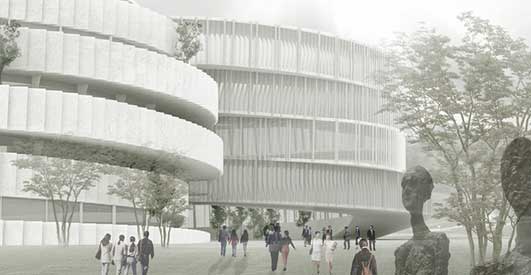
image from architect
Wooden Wave Cultural Center
Design: TheeAe Ltd

image from architect
Taichung Cultural Center Competition Entry
Design: Pruthiphon Buakaew
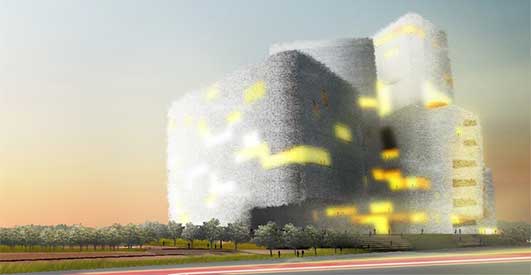
image from architect
Taichung City Cultural Center
Design: Kubota & Bachmann Architects
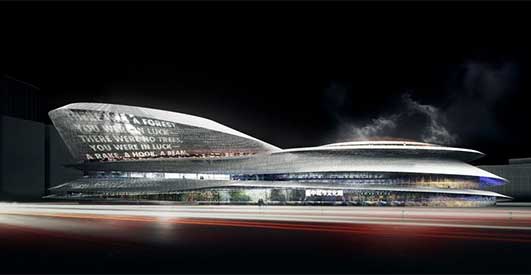
image from architect
Taiwan Library Architecture Competition
Comments / photos for the Taichung City Cultural Center – Taiwan Architecture page welcome

